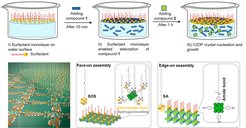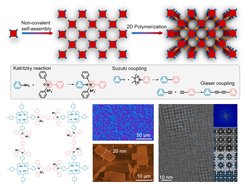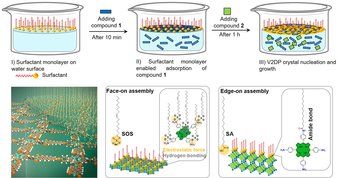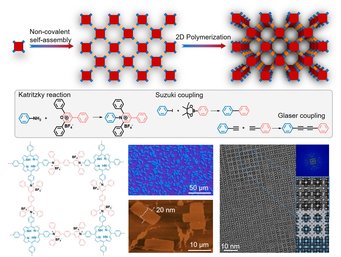2D Polymer & Interfacial Synthesis
Dr. Zhiyong Wang
In this group, we mainly focus on the development of organic 2D materials (O2DMs), which refer to crystalline 2D nanostructures comprising carbon-rich repeated units linked by covalent/noncovalent bonds, including synthetic crystalline 2D polymers (2DPs), 2D supramolecular polymers (2DSPs), single/few-layer 2D COFs/MOFs, etc. We expect to establish novel chemical/synthetic methodologies toward the controlled synthesis of O2DMs and achieve delineation of reliable structure-property relationships and superior physical and chemical performances.
Research Area I: Development of interfacial synthesis methodologies

An interface is a flat or curved space (or phase boundary) between two different matters, or two different phases in one matter. The thickness of the interface space can range from a few angstroms to nanometers and even micrometers. In our work, we aim to develop interfaces as key roles in “bottom-up” synthesis, which is advantageous for directing the preorganization of the molecules or precursors for subsequent 2D polymerization toward O2DMs. Typically, the reactions at the interfaces between air-water (or gas-liquid), liquid-liquid, liquid-solid, and gas-solid (or vacuum-solid) are explored for the 2D polymerization by linkage chemistry and the paramount control over the morphology and the structure of O2DMs. In our latest work, we have discovered the surfactant-monolayer-assisted interfacial synthesis (SMAIS) method for the preparation of 2DPs such as 2D polyimides, 2D polyimines, 2D polyboronate esters and 2D poly(pyridinium salt)s, with tunable thicknesses and micrometer-sized individual crystalline domain.
Research Area II: Synthetic chemistry of O2DMs

Dynamic covalent reactions: We aim to explore thermodynamically reversible dynamic covalent reactions (DCRs) for the synthesis of crystalline O2DMson the water/liquid surface. DCRs allow the atomically precise integration of organic units to create periodic networks with long-range order linked by covalent bonds. A key feature of DCRs is the thermodynamically controlled product distribution at equilibrium. Typical examples of DCRs include the formation of imine, boronate ester, imide and amide bonds. In our recent work, by combining DCRs and SMAIS, we successfully achieved few-layer 2DP single crystals with the domain size up to ~60 μm2.

Irreversible covalent reactions: We aim to explore the utilization of kinetically irreversible covalent reactions (ICRs) for the synthesis of O2DMs, which is highly attractive but remains a challenge. To achieve the long-range order and layered crystals, 2D polymerization will be carried out under kinetic control, which relies on the preorganization of monomers prior to bond formation. Typical ICRs including Knoevenagel, Aldol and Horner-Wadsworth-Emmons condensation reactions have been developed for the solvothermal synthesis of vinylene-linked 2D COFs, yielding fully conjugated polymeric materials with high chemical and thermal stability. On the other hand, structurally-defined conjugated 2DPs can be realized via the on-surface Ullmann coupling under ultrahigh vacuum conditions. Recently, we also performed the Katritzky reaction and oxidation polymerization on the water surface by SMAIS and developed highly crystalline charged 2D poly(pyridinium salt)s, and quasi-2D polyaniline thin film, respectively.
Research Area III. Functions for electronics, vdWhs and membranes

Benefitting from their tailor-made porous structures and functionalities on the molecular level, synthetic O2DMshave exhibited excellent physical and chemical properties, making them the most promising candidates in electronics, optoelectronics, membranes, catalysis and energy storage and conversion. In our work, we aim at the design and synthesis of novel O2DMs with molecular precision that enable effective ion/charge transport. In addition, we aim to establish the structure-property relationship, and explore their applications in electronic (e.g., field-effect transistors (FETs), sensors, neuromorphic devices) and optoelectronic (e.g., photodetectors, electrochromic devices) devices, van der Waals heterostructures, and membranes for artificial skin in batteries, fuel cells and osmotic power generators.



